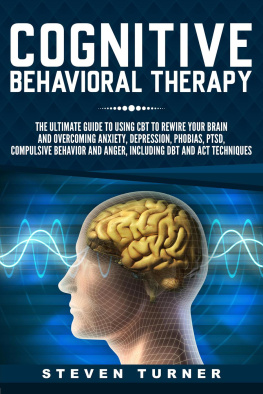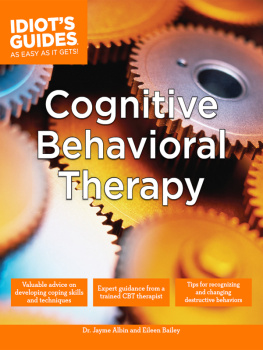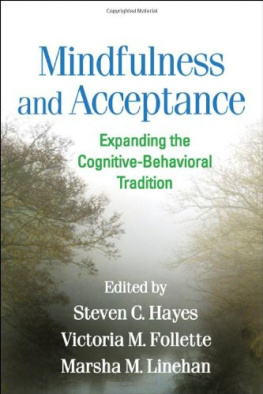Cognitive-Behavioral
Play Therapy
Cognitive-Behavioral
Play Therapy
SUSAN M. KNELL, PH.D.

PLAY-DOH is a registered trademark of Tonka Corporation. Copyright 1993 Playskool, Inc. Used with permission.
A JASON ARONSON BOOK
ROWMAN & LITTLEFIELD PUBLISHERS, INC.
Published in the United States of America
by Rowman & Littlefield Publishers, Inc.
A wholly owned subsidiary of The Rowman & Littlefield Publishing Group, Inc.
4501 Forbes Boulevard, Suite 200, Lanham, Maryland 20706
www.rowmanlittlefield.com
PO Box 317
Oxford
OX2 9RU, UK
Copyright 1993 by Jason Aronson Inc.
1997 softcover printing
First Rowman & Littlefield Edition 2004
All rights reserved. No part of this publication may be reproduced, stored in a retrieval system, or transmitted in any form or by any means, electronic, mechanical, photocopying, recording, or otherwise, without the prior permission of the publisher.
British Library Cataloguing in Publication Information Available
Library of Congress Cataloging-in-Publication Data
Knell, Susan M.
Cognitive-behavioral play therapy / by Susan M. Knell
p. cm.
Includes bibliographical references and index.
ISBN: 978-1-56821-719-2
1. Play therapy. 2. Cognitive therapy for children. I. Title.
[DNLM: 1. Cognitive Therapyin infancy & childhood. 2. Play Therapyin infancy & childhood. 3. Play Therapymethods. WS 350.2 K68c]
RJ505.P6K6 1993
618.9289165dc20
DNLM/DLC
For Library of Congress
92-49558
Printed in the United States of America
 The paper used in this publication meets the minimum requirements of American National Standard for Information SciencesPermanence of Paper for Printed Library Materials, ANSI/NISO Z39.48-1992.
The paper used in this publication meets the minimum requirements of American National Standard for Information SciencesPermanence of Paper for Printed Library Materials, ANSI/NISO Z39.48-1992.
To Martin and Sylvia Globus Knell
and Robert Shafran
for their love and support
Contents
| by Christine D. Ruma, M.S., M.S.S.A. |
Authors Note
The names and other identifying details in individual case histories have been changed to protect the privacy of the children and families presented.
A wide variety of cognitive and cognitive-behavioral therapies have been developed. To avoid confusion, the term Cognitive Therapy is used when referring to the work of Aaron T. Beck, M.D. The term cognitive-behavioral therapy is used generically to refer to a wide range of approaches based on cognitive and behavioral principles and intervention strategies. Because the present work is based on the integration of cognitive, behavioral, and play therapy, the term Cognitive-Behavioral Play Therapy has been chosen.
Acknowledgments
When Charles Schaefer, Ph.D., first asked me to contribute to his series on child psychotherapies, I was delighted at the prospect of introducing the notion of Cognitive-Behavioral Play Therapy to other child clinicians. I appreciate his support and assistance in this project, and his encouragement of my work.
I am especially grateful to James Overholser, Ph.D., who reviewed many chapter drafts with attention to detail and stylistic acumen. Jim has been a wealth of knowledge, and a tremendous resource.
Richard Paulson, Executive Director of the Child Guidance Center, and his staff have been immeasurably encouraging and supportive of my work. My association with this dedicated group of professionals has been most rewarding.
In the early stages of this work, I talked with a number of individuals about the idea of integrating cognitive-behavioral interventions with play therapy. E. Klonoff, Ph.D., provided some useful thoughts that led me to think more systematically about the integration of cognitive and behavioral interventions with very young children. Douglas Moore, Ph.D., contributed to my understanding of the encopretic child described in abused children contributed to my thinking as well as to the work done by members of the Sex Abuse Treatment Team at the Child Guidance Center of Greater Cleveland. The chapter on sexually abused children by Christine Ruma, M.S., M.S.S.A., includes a number of cases treated by Linda. Chris shares my enthusiasm for the integration of cognitive-behavioral interventions and play therapy, and has been a pioneer in her application of this approach with children who have been sexually molested.
A number of students provided technical support, and at times their enthusiasm could not help but be contagious. I would particularly like to thank Laura Hubbert DiCarlo, who provided library assistance and transcribed audiotapes of clinical sessions with painstaking detail.
Finally, I have learned from the children and families with whom I have worked over the years. This book would never have been possible without them. Cognitive-Behavioral Play Therapy grew out of an effort to find a better match to the needs of the individual children and families I have seen. I hope that my search for new treatment options has been helpful to them and ultimately will be helpful to others.
PART I
PLAY THERAPY
traces the historical development of play in child psychotherapy, as well as the emergence of play therapy. The varying schools of thought, including psychoanalytic, structured, relationship, nondirective, limit setting, group, and behavioral therapies, are considered. A number of trends in play therapy are presented. These include the focus on short-term interventions, treatment used for preventive purposes, feedback mechanisms (e.g., videotape), and increasing emphasis on finding a match between therapy type and child. A renewed interest in the field of play therapy has generated numerous books and articles, and the formation of a national association of play therapy.
childhood disturbances. Cognitive functioning, as well as affective and emotional development, must be considered in therapeutic work with children. In some recent studies, Piagets work on the childs understanding of conservation as it relates to measurable properties has been applied to the childs understanding of affective functioning. This work has important implications for the childs understanding of emotional and social phenomena. Clinical implications of the childs cognitive, linguistic, and affective development are related to treatment planning. Other clinical issues such as referral factors and sources of assessment data are discussed and their implications for cognitive-behavioral therapy are considered.
1
Approaches to
Play Therapy
PLAY AND ITS IMPORTANCE IN CHILDHOOD
Is it possible to consider play therapy without first understanding what is meant by play? Perhaps not, but defining play is a difficult task. There is no single, accepted definition of play, although it seems easier to define play by what it is not than by what it is. Play is considered the opposite of work. It is fun and pleasurable. It has no extrinsic goals. It is, according to Webster, action or exercise for amusement; recreation; sport. And according to Erikson (1964), in its own playful way, it tries to elude definition (p. 4).
In the context of play, children practice new roles, express emotions, try to make sense of experiences, and deal with both reality and fantasy. A childs play is influenced by parental factors, experiences with peers, available materials, school, and the media (Rubin et al. 1983). The multifaceted nature of play and its meaning make it an invaluable, if complicated tool for use in therapy.












 The paper used in this publication meets the minimum requirements of American National Standard for Information SciencesPermanence of Paper for Printed Library Materials, ANSI/NISO Z39.48-1992.
The paper used in this publication meets the minimum requirements of American National Standard for Information SciencesPermanence of Paper for Printed Library Materials, ANSI/NISO Z39.48-1992.